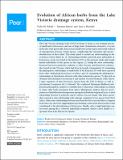| dc.contributor.author | Violet M. Ndeda1, 2 , Mariana Mateos1 and Luis A. Hurtado1 | |
| dc.date.accessioned | 2022-01-30T11:39:02Z | |
| dc.date.available | 2022-01-30T11:39:02Z | |
| dc.date.issued | 2018 | |
| dc.identifier.uri | https://repository.maseno.ac.ke/handle/123456789/4785 | |
| dc.description | DOI 10.7717/peerj.5762 | en_US |
| dc.description.abstract | The Lake Victoria drainage basin (LVD) in Kenya is home to ten nominal species
of small barbs (Enteromius) and one of large barbs (Labeobarbus altianalis). A recent
molecular study genetically characterized small barbs in this region and found evidence
of introgression between certain species, complicating the taxonomy and species
identification of these fishes. This study aimed to extend our understanding on the
evolution of these fishes by: (1) determining whether putatively pure individuals of
Enteromius cercops are found in the Kenyan LVD, as the previous study only found
hybrid individuals of this species in this region; (2) testing the sister relationship
between Enteromius profundus, endemic to Lake Victoria, and Enteromius radiatus,
also found in Lake Victoria, which had been previously synonymized; (3) examining
the phylogenetic relationships of small barbs of the Kenyan LVD with those reported
from other ichthyological provinces of Africa; and (4) examining the phylogenetic
relationships of Labeobarbus altianalis with other Labeobarbus species. To this end, we
obtained mitochondrial Cytochrome b and nuclear Growth Hormone (GH) intron
2 gene sequences of nine Enteromius species from the LVD in Kenya, as well as
cytochrome b sequences for L. altianalis. We conducted Maximum likelihood and
Bayesian phylogenetic analyses to establish their evolutionary relationships in relation
to many other barbs specimens from Africa. Phylogenetic analyses did not reveal
instances of hybridization/introgression among the individuals sequenced by us. A sister
relationship between E. profundus and E. radiatus was not found. This latter species
shows instead a sister relationship with a lineage comprised of two species from West
Africa. Other sister relationships between taxa from the East coast and other ecoregions
from Africa are observed, suggesting that past drainage connections and vicariant events
contributed to the diversification of Enteromius. Finally, only a single haplotype was
recovered among the L. altianalis individuals examined, which is most similar to a
specimen from Lake Edward in Uganda | en_US |
| dc.publisher | PeerJ Inc. | en_US |
| dc.subject | Mitochondrial, Phylogeny, Cytochrome b, Barbus, Enteromius, Biogeography, Lake Victoria, Africa, Kenya, Cyprinidae | en_US |
| dc.title | Evolution of African barbs from the Lake Victoria drainage system, Kenya | en_US |
| dc.type | Article | en_US |

